Jaguar XKR-S Coupe renews dream of XKE
By John Gilbert
After easing the new Jaguar XKR-S coupe nose-first up to the curb, I climbed out, locked it with the remote, and was walking slowly away, unable to resist the urge to look back at the car’s beautifully coordinated lines. I didn’t even see the fellow approaching from the other direction, but I heard his voice.
“That’s as exotic as it gets,” he said, making more of a statement than a question that needed no answer.
I smiled at him and nodded in agreement. “I mean, you hear about Ferraris and Lamborghinis, but they can’t be any more exotic than this car.”
He was right. The new XKR-S is a long, low, slinky, sexy car, either in coupe or convertible form. This one happened to be the coupe, and it was the cause of a recurring dream for me. I suppose the dream began back when I was a young driver, back in the 1960s, and as I had pulled over in the dark of night on Highway 61, where flashing lights had indicated a patrol car had stopped, fortunately for only a minor accident.
Headlights approached, and a car arrived shortly behind them. Only it wasn’t just another car. When the occupants realized nothing serious had happened, they made a u-turn and drove away, revving to a high-pitched scream as their car disappeared around the corner and into the darkness. The car was a Jaguar XK-E, and its image was riveted in my mind as the most exotic car I had ever seen, first-hand, on the streets or highways near Duluth.
The car, and the British company, have undergone a number of changes over the last 40 years, and the letter designation of the Jaguar sports car has escalated. It is up to XKR by now, but the car has never lost its dreamy characteristics, even though it has gained considerably in the areas of sophistication, technology and performance.
You’ve heard of recurring nightmares, but recurring dreams? My dream may have had a preview way back then on the dark Hwy. 61, but the more solid part of the dream was the brief opportunity to drive the new XKR-S at Road America, the 4-mile road-racing course at Elkhart Lake, Wis. There was a nice mix of cars and automotive media-types when the Midwest Auto Media Association (so help me, it’s MAMA), gathered nearly 100 of each for a two-day performance venture. Media folks have the opportunity to select any car and take it out for a one-lap run, presumably keeping speed within reason.
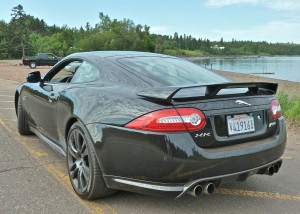
All the lines come together at the spoiler-topped rear, with quad pipes underscoring the "Leaper" emblem.
There were several high-performance cars, ranging from a Corvette, Camaro ZL-1, Cadillac CTS-V hat trick of coupe, sedan, and wagon, and a similar hat trick from Mercedes, including C63 AMG coupe, SLK55 AMG, and SLS Roadster, plus BMW turbocharged sedans, a couple of Audi sedans, a Lancer Evolution GSR, a Nissan GT-R, Lexus GS F, Subaru BRZ, Porsche Carrera S, Genesis Coupe R-Spec, Volkswagen Golf R, Taurus SHO, Mustang Boss 302, Dodge Challenger and Charger SRT8s, Chrysler 300 SRT8, and a Jeep Grand Cherokee SRT8. I drove most of them, on the road course, or later on an autocross, and all were impressive in their various manners.
But I was the most impressed after strolling past the gathered lineup of high-performance cars when I decided to try a dark, black Jaguar XKR-S. I waited in line in the pit area, then was signalled out on the track. Unrestrained by any speed limit, I was pushed back into the seat before Turn 1, then I whistled around the turn and down through Turn 2. That leads onto a long, slightly curving straightaway that ends with a 90-degree left turn at the bottom of an abrupt hill. The Jag felt so comfortable, I had no problem building the speed up through the automatic transmission.
As I swept down the hill, knowing full well I’d have to harness all that speed for the sharp turn, I glanced at the speedometer: It read 140. The brakes were easily up to hauling down from that speed, and I continued around that swift lap before cruising up the exit and back to the paddock parking place. Read more
Volvo S60 T5 upgrade deserves a medal
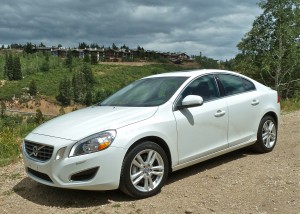
Volvo S60 T5 adds all-wheel drive for 2013, the easier to reach Utah's Stein Eriksen Lodge, in the background.
By John Gilbert
PARK CITY, Utah — Returning to the driver’s seat of a Volvo S60, and returning to Utah’s mountainous ski country were similarly familiar, particularly when both circumstances coincided with the late-July opening of the 2012 Olympics.
True, the 30th Summer Olympics — or the XXX Games, for those who prefer their competition X-rated — were starting in London, but the Winter Olympics were held in Salt Lake City in 2002 and remain riveted in memory because. I worked for the Olympic Committee at Salt Lake City, as supervisor of all the hockey information dispersed over the intranet service for the assembled hundreds of media from around the world. My wife, Joan, was a member of my six-person staff, and we worked tirelessly to produce swift and accurate news reports, even in the face of constant pressure by a National Hockey League official determined to turn the the Olympics into an NHL PR-event.
That’s another story. But when Volvo decided to introduce the final version of the popular S60 midsize sedan at Park City, where some of the 2002 ski events were conducted, it was a cinch, and it became a unique event when Volvo also asked auto-media types to bring along a spouse or other guest. The car as mainstream family vehicle was the obvious focal point, but we also were given the opportunity to visit Utah Olympic Park, to watch a unique presentation by the Flying Ace All-Stars, a group of past, present and future Olympic and world extreme ski-jumpers, and even to examine the bobsled, luge and ski jumping courses. Later we rode the Xtreme Zipline — the fastest way down from the mountaintop.
The S60 is Volvo’s mainstream staple, and between 2010 and 2012, Volvo has offered it as a high-performance turbocharged 6-cylinder, all-wheel-drive sporty vehicle, and as a more docile 5-cylinder, front-wheel-drive car.
Logic, and marketing pressure, left a large opening between those two extremes, and that is what Volvo is filling for 2013, upgrading the base 5-cylinder to a turbo all-wheel-drive model that covers the best of both worlds — performance and fuel-efficiency — while adding the all-wheel drive feature that now separates all-weather superstars from marginalized competitors.
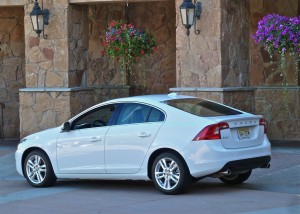
Forget the image of boxy Volvos; the new S60 T5 AWD is even at home as a Swedish car at a Norwegian's resort.
Our first impression was how free of wind or tire noise the car is, so S60 fans needn’t be concerned. But with the new model, you could say FWD might win the bronze, or even the silver, but it will take AWD to win the gold in areas where foul-weather driving is common.
First introduced as a 2001 model, the S60 was positioned between the larger luxury S80 and the more compact S40. A solid and steadfast all-season car with traditional Volvo safety benefits, and the most comfortably supportive seats in the industry, the S60 did right well in sales. A couple years later, Volvo added the S60-R, which transformed a nice family sedan into a turbocharged, all-wheel-drive, high-performance hot rod. Despite the obvious resemblance to a boxier heritage, it was my favorite Volvo ever.
After the normal five- or six-year plan for the redesigning, Volvo ran into an economic roadblock. It was 2007, and the bottom was falling out of the car market along with the rest of the economy. Ford, which owned Volvo at the time, convinced its Swedish affiliate to hold back on building the new S60 because of costs. Ford’s foresight helped it avoid bankruptcy bailouts that its top competitors, General Motors and Chrysler Corporation, required to remain in business. Ford later sold Volvo, Jaguar, Land Rover, and its majority share in Mazda. All are currently succeeding in the world marketplace.
Volvo is now owned by the Zhe-Zhiang holding company of China, which also owns Geely, a Chinese auto-maker. Volvo, which never compromised on making arguably the safest fleet of vehicles on the planet, moved onward and upward with the infusion of new money from a nation that has become the top automotive market in the world, as well as the manufacturer of current U.S. Olympic uniforms. Among the first orders of business was introducing the second generation S60, which hit the streets in 2010 as a stylish departure from the previous boxiness of Volvos. No more boxy corners, replaced by stylish and aerodynamic slopes and contours.
Surprisingly, Volvo surprised the auto world by introducing the S60 as an all-wheel-drive turbo 6-cylinder in 2010, with over 300 horsepower and torque figures, possibly as a determined effort to show that things were going to be different in Gothenberg. It wasn’t until six months later that Volvo followed with its high-volume, mainstream version of the car, with a 5-cylinder engine and only front-wheel-drive, with a lower price and better fuel economy. Earlier this year, Volvo expanded the input of Polestar, its high-performance electronic tuning affiliate, and created an even-more potent S60 T6.
That still left room for one more model — the T5. Turbocharging the 5-cylinder increases its power to 250 horsepower and 256 foot-pounds of torque, important to aid with the added all-wheel drive. Read more
Malibu hustles to join midsize maze
By John Gilbert
In the face of onrushing new midsize cars from competitors, Chevrolet answered with a pre-emptive move — hustling out the 2013 Malibu so far ahead of plans that the car virtually beat its own engine to the showrooms.
The Malibu rekindled fond memories when it returned after a decade of extinction in the mid-1990s, and it might rekindle memories of Chevrolet’s once-lofty status for producing state-of-the-art midsize sedans if the totally redone 2013 model lives up to its initial ratings.
Chevrolet undoubtedly knew midsize competition was fierce and getting fiercer, as the Toyota Camry segment king has already been revised, and the Hyundai Sonata and Kia Optima Korean breakthrough siblings challenged for prominence. A new Nissan Altima generation has just been introduced too, soon will be joined by the renewed Honda Accord and the much-publicized new Ford Fusion.
If a drastic measure was called for, the new Malibu is taking a healthy swing at the challenge a year ahead of original schedule. It will be offered only as a 4-cylinder Eco, with GM’s “eAssist” mild hybrid scheme, while General Motors finishes building its all-new 2.5-liter 4-cylinder, which should be available later in 2012. Even then, the pair of 4-cylinders will be the only choices, as Chevy joins the trend of dropping V6es in favor of higher-output 4s with far better fuel economy.
Styling has been a feature of Malibus since the 1960s, when it was born as a fancy upscale model of the Chevelle. When Malibu was brought back in 1997, it was nice enough, but seemed to slip a little when some competitors in the congested midsize class took some bold styling steps. The new Malibu makes up for some of that.
It has the new-signature corporate grille, with a large trapezoidal opening, split by a horizontal bar above the midpoint. That identifying trademark first appeared on the previous Silverado pickup redo, and has since proliferated to distinguish the Volt, Cruze, subcompact Sonic and mini-car Spark, along with the Malibu.
That’s one of the issues with a so-called “signature” look: At a glance, you’re uncertain what’s coming at you, and Malibu buyers might be less than thrilled that their front end has a Cruze-Sonic look. It is, however, an asset from the rear, where the sculpturing of the rear bumper and tail, with four square taillights, and a spoiler lip designed into the trunklid, make a strong resemblance to the stylish and muscular Camaro.
Overall, the look retains the appearance of the outgoing Malibu, until you scrutinize all the elements, even though the car now switches to a shorter-wheelbase platform. The hood has some nicely contoured lines that sweep back to the “A” pillar framing the windshield and front doors, and the silhouette has a pleasant, contemporary look. Read more
Ford adds 1.0-liter EcoBoost to Focus
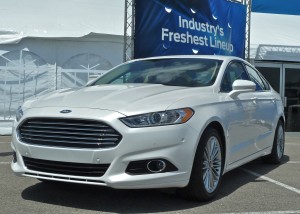
Ford hasn't yet introduced the 2013 Fusion, but it is the company's inspiration and technical halo car.
By John Gilbert
DEARBORN, MICH. — Smaller is big at Ford these days, and for 2013 the Dearborn company is expanding its highly successful EcoBoost technology to even smaller engines that will outwork larger ones while increasing fuel economy. Can you imagine a company that makes an impressive 6.2-liter V8 in its trucks will also be offering a 1.0-liter, 3-cylinder that propels a compact Focus with quick agility?
Ford Motor Company gained enormous amounts of respect and credibility when it foresaw the economic downturn and reacted strategically enough that it didn’t need the government loans that bailed out General Motors and Chrysler. Almost daily, I run into folks who have never been Ford fanciers but who now say they intend to examine Ford’s array of products before making their next purchase.
With that as background, dozens of automotive media types were herded to Dearborn for an advance check on the company’s 2013 vehicles, inside the secured walls of Ford’s Development Center.
I was able to fly in and out of Detroit on the day of the unveilings, so when I was whisked to the Tech Center, the groups of journalists had already started off in their four different groups. I was bused to the location of a lecture, but outside, I spotted a line of Focus sedans and hatchbacks on a tight little road-course, so I ambled over that way. Several Ford officials put me into a Focus and turned me loose. I zoomed away without a sound, because I was driving the new Focus Electric, with no gas-engine backup. Housing a new lithium-ion battery pack with permanent magnetic electric traction motor, the car had surprising quickness and, naturally, no emissions as well as no sound. The system is designed to produce 143 horsepower and 184 foot-pounds of torque, reaching a top speed of 84 mph, and go 76 miles on a full charge, which takes four hours on a 240-volt home-charging station. It will cost $39,200, and obviously is designed to challenge the Chevrolet Volt, Nissan Leaf, Mitsubishi Miev, Honda Fit Electric and all others.
That’s a lot of money for a Focus-size car, but that’s where costs are at these days in creating electric cars. Ford also has an electric-powered C-Max compact wagon, the Energi, being sold in Europe with pure electric, and coming to the U.S.
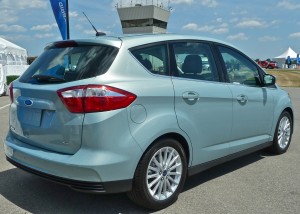
Based on the Focus, the C-Max will first come to the U.S. as hybrid or electric, but the 1.0 EcoBsoost is sure to follow.
Next, I climbed into a different Focus — I suppose you could say I reFocused — and took off around the same course, up and down some little hills and around some tight curves. This was obviously powered by a gas engine, but what an amazing gas engine! Designed and built in Europe, where it raked in all sorts of awards such as best new engine and 2012 engine of the year by the largest vote margin ever among 76 journalists from 35 countries, this engine is a tiny 1.0-liter in displacement, with only three cylinders.
It is the newest and smallest of Ford’s EcoBoost engines, which apply turbocharging to extract surprising power from reduced displacement. The Focus 1.0 comes in two versions, one with 98 horsepower that attains 58.9 miles per gallon, and the other with a more potent 123 EcoBoosted horsepower, getting “only” 56.4 mpg. Read more
Twins entertain, regardless of record
By John Gilbert
As we head into the All-Star break, one thing has become remarkably evident. It doesn’t matter whether the Minnesota Twins scratch and claw their way to .500, or even into contention in the second half, rarely have they been as interesting to watch as this season.
Joe Mauer is the only Twins player headed for the All-Star game, and justifiably after he hit something like .495 for the month of June. And — you read it here first — he will come back and win his fourth AL batting title. Whether he does or not, the Twins have been captivating for baseball fans willing to overlook the frustration of the first six weeks and enjoy the sheer entertainment value the team is offering.
We have catcher-first baseman-designated hitter Mauer as an emblem of the whole Twins season. Off to his worst first month as a Major Leaguer, Mauer has been amazing as he’s climbed to third in the American League batting race. Justin Morneau, his M&M twin until both were plagued with injuries last season, is starting to hit too, and I anticipate a really strong second half for him.
When both of them were slow starting, the Twins were too, as their plunge to the bottom of the standings rotated among failures to hit, score, play defense, and pitch, and usually a combination of at least two of the above.
Talk radio bozos in the Twin Cities — the same ones who have been on Joe Mauer’s case the last two years — were actually suggesting the Twins would have to dismiss manager Ron Gardenhire when things were going bad. Poor Gardy was the victim, rather than the problem, in the first six weeks. It’s tough to come out of Spring Training fired up for a strong season and have everything sputter for over a month.
On the other hand, the current rise of the Twins to respectability has ridden some odd inspirational forces. First off, Scott Diamond was banished to the minors early in training camp, but since being called up in desperation a month ago, Diamond has been the Twins best pitcher. True, Francisco Liriano has come up with a few gems in recent starts too, but he is just living up to expectations when he does that. Finally.
The major sources of inspiration have been twin home run hitters. No, not Mauer and Morneau, but Josh Willingham and Trevor Plouffe. Reports were that Plouffe had “some pop” in his bat, and would be playing for the Twins as soon as he could get a chance and adjust to Major League pitching.
Willingham, signed as a free agent after the Twins let Michael Cuddyer and Jason Kubel both go via free agency, was one of the scariest outfielders I’ve ever seen in a Twins uniform. There have been some real dandies in that category, but early in the season, I watched Willingham misplay pop flies, and once he raced toward left-center for a soft, Texas League single, and he flat over-ran the ball, which went behind him for a double or triple. That was back when we were wondering where the Twins might hide Willingham, since the DH spot was usually filled by Mauer or Morneau.
We also wondered where Plouffe might fit in. Now, as we reach midseason, Willingham has worked hard to improve his defensive play and has now reached the level of at least adequacy. He’ll never be the defensive stalwart Denard Span is in center, or the mercurial Ben Revere is in right, but he’s no longer a liability in left. Especially because he is pounding the ball.
Plouffe, meanwhile, is making strong plays at third base, and the pop in his bat is sending pitch after pitch into the seats, home or road. In Tuesday night’s game at Detroit, the Twins led 1-0, then fell behind 4-1. With two out in the fifth, Revere singled, and his speed prompted a balk, and may have provoked a wild pitch. Mauer socked one up the middle that was very tough to handle behind second base, and he was safe on an error as Revere scored. Next up was Willingham, and he launched one into the left field seats.
The two-run homer tied the game 4-4. It also was Willingham’s 18th homer of the season, tying him with Plouffe for the team lead. After Morneau went out, however, Plouffe came up and whacked another pitch into the left-field seats to give the Twins the lead, reclaiming the team HR lead at 19. It was the sixth time this season that both Willingham and Plouffe had homered in the same game. The game later was tied 6-6 in the seventh when Mauer and Willingham both socked opposite-field doubles, and a sac-fly later, the Twins regained the lead in the crazy game at 7-6.
In the last of the seventh, the Twins got into a bind of sorts, but when slugger Miguel Cabrera blasted a line drive down the third base line, Plouffe lunged to stab the shot with his glove, then fired a bullet across to first for a double play. Just for insurance, Mauer came up again to lead off the ninth, got to a 3-1 count, and drilled a home run to left for an 8-6 cushion. In came Glen Perkins, a fireballing left-hander who has adapted well to the role of closer with Matt Capps out with an injury. Perkins blew down the Tigers to complete a four-game sweep for the Twins.
Go back to the start of the season, when most observers were picking the Tigers, with Prince Fielder added to Cabrera in a potent lineup, to win the pennant, and they were just as certain the Twins would be at the bottom. The Twins are still at the bottom, but you couldn’t prove it by the Tigers, who were sent into another tailspin by the Twins.
It almost seems as though the early-season struggles forced the Twins to play some questionable players in the infield and outfield, but by sheer repetition, or latent skill, those players have become fixtures. At the same time, the pitching staff is improving, with the starters getting better and better, and the middle relief always solid, while Perkins has been nothing short of sensational as the middle-reliever turned closer.
The Twins are poised to play a tough second half. Will it be good enough to get into contention? Probably not. But who cares? The Twins are providing entertainment, night after night, and nothing is predictable or impossible.


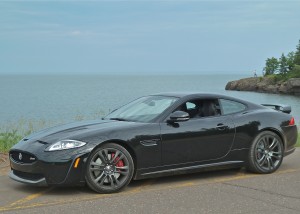
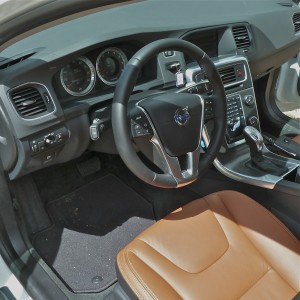
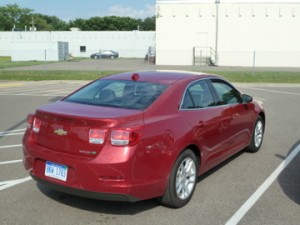
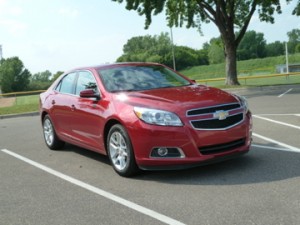
 John Gilbert is a lifetime Minnesotan and career journalist, specializing in cars and sports during and since spending 30 years at the Minneapolis Tribune, now the Star Tribune. More recently, he has continued translating the high-tech world of autos and sharing his passionate insights as a freelance writer/photographer/broadcaster. A member of the prestigious North American Car and Truck of the Year jury since 1993. John can be heard Monday-Friday from 9-11am on 610 KDAL(www.kdal610.com) on the "John Gilbert Show," and writes a column in the Duluth Reader.
John Gilbert is a lifetime Minnesotan and career journalist, specializing in cars and sports during and since spending 30 years at the Minneapolis Tribune, now the Star Tribune. More recently, he has continued translating the high-tech world of autos and sharing his passionate insights as a freelance writer/photographer/broadcaster. A member of the prestigious North American Car and Truck of the Year jury since 1993. John can be heard Monday-Friday from 9-11am on 610 KDAL(www.kdal610.com) on the "John Gilbert Show," and writes a column in the Duluth Reader.